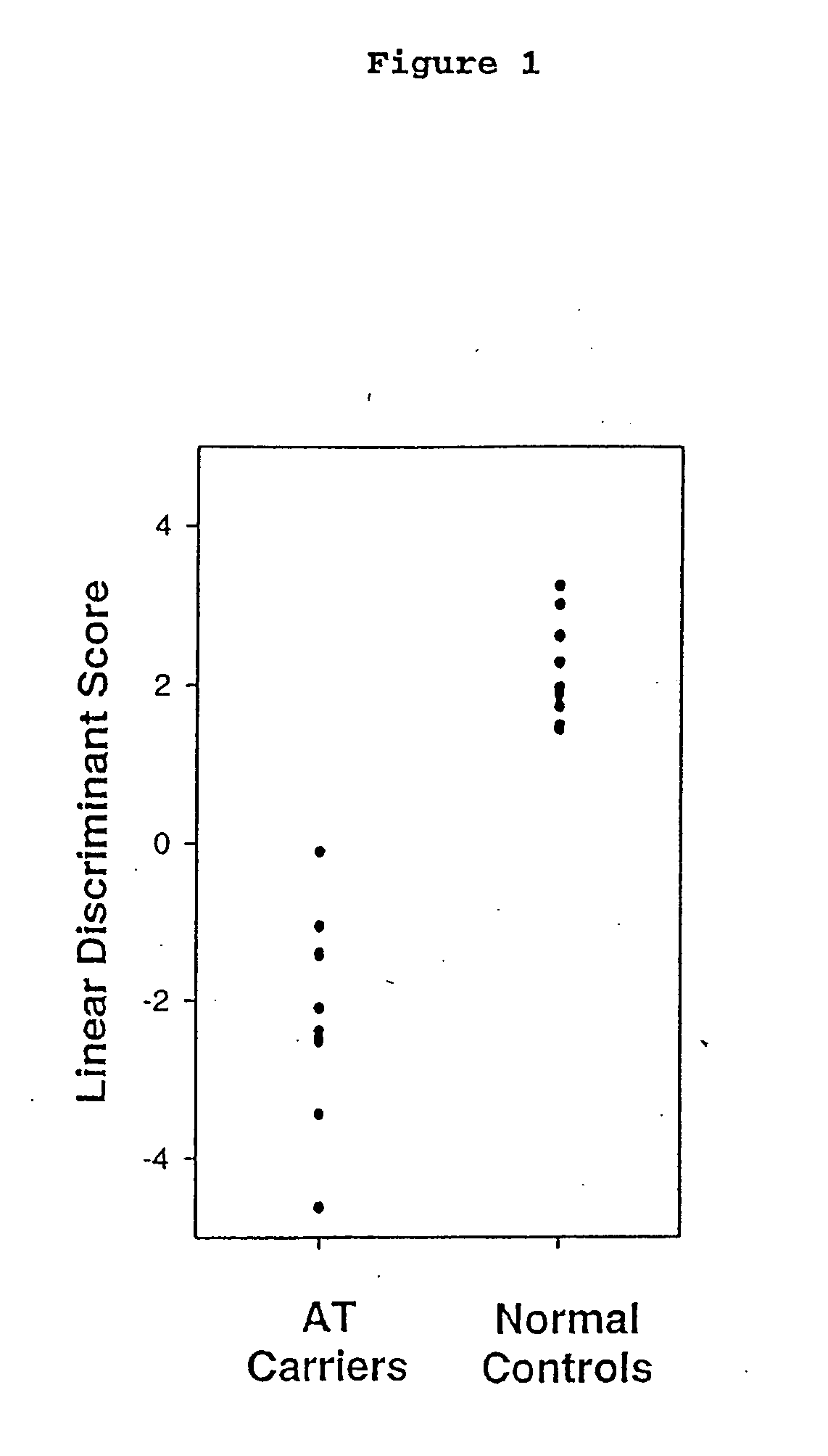Methods for identifying heterozygous carriers of autosomal recessive diseases
a technology of autosomal recessive diseases and heterozygous carriers, applied in the field of dna microarray technology, can solve the problems of shortened lifespan, elevated risk of cancer, and inability to precisely identify the diagnostic assay, and achieve the effect of facilitating hybridization
- Summary
- Abstract
- Description
- Claims
- Application Information
AI Technical Summary
Benefits of technology
Problems solved by technology
Method used
Image
Examples
example 1
Expression Analysis Reveals Cellular Phenotype of Heterozygous Carriers of ATM Mutations
[0032] Using cDNA microarrays to monitor gene expression levels, it was determined that alterations in gene expression patterns differentiate heterozygous carriers of Ataxia Telangiectasia (AT) from normal individuals. The differences are manifested in both baseline expression levels and in response to ionizing radiation (IR). These findings provide a novel approach to diagnose AT carriers and may also facilitate an understanding of the molecular basis of their increased risk to cancer.
I. Materials and Methods:
[0033] The following protocols are provided to facilitate the practice of the present invention.
[0034] Baseline expression levels: Lymphoblastoid cell lines were obtained from 10 obligate AT carriers (GM08931, GM03334, GM03382, GM03188, GM09588, GM00736, GM02781, GM09585, GM09583, GM09579) and 10 normal control individuals (GM06995, GM06997, GM07014, GM10832, GM10835, GM10848, GM10849,...
example 2
Methods for Identifying Heterozygous Carrier of Autosomal Recessive Disorders
[0068] The method described in Example 1 for identifying AT carriers from normal individuals based on altered gene expression patterns may be adapted to identify heterozygous carriers of a variety of other autosomal recessive disorders including, but not limited to Cystic Fibrosis (CF), Sickle Cell Anemia, Tay-Sachs disease, Phenylketonuria (PKU), Oculocutaneous Albinism (OCA), Hereditary Haemochromatosis (HH), AAT deficiency, ADA deficiency, β-thalassemia, alpha-1 antitrypsin deficiency, Spinal Muscular Atrophy, Friedreich's Atoxia, and Congenital Adrenal Hyperplasia.
[0069] To identify heterozygous carriers of autosomal recessive disorders, cDNA microarrays may be used to examine the expression profiles of total RNA from lymphoblastoid cell lines of heterozygous carriers for any one of the autosomal recessive disorders which have been previously identified by conventional means and lymphoblastoid cell li...
PUM
| Property | Measurement | Unit |
|---|---|---|
| Tm | aaaaa | aaaaa |
| pH | aaaaa | aaaaa |
| temperature | aaaaa | aaaaa |
Abstract
Description
Claims
Application Information
 Login to View More
Login to View More - R&D
- Intellectual Property
- Life Sciences
- Materials
- Tech Scout
- Unparalleled Data Quality
- Higher Quality Content
- 60% Fewer Hallucinations
Browse by: Latest US Patents, China's latest patents, Technical Efficacy Thesaurus, Application Domain, Technology Topic, Popular Technical Reports.
© 2025 PatSnap. All rights reserved.Legal|Privacy policy|Modern Slavery Act Transparency Statement|Sitemap|About US| Contact US: help@patsnap.com



